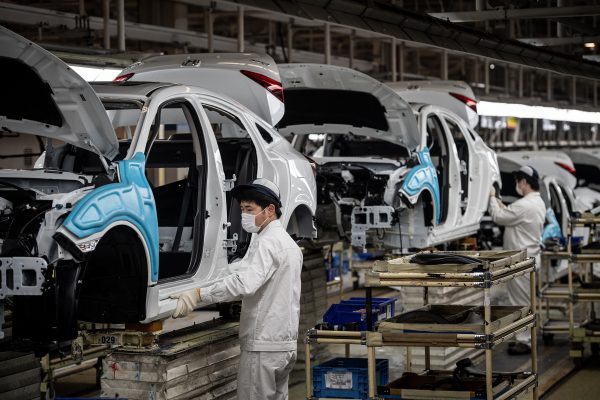Securing supply chains after COVID-19

The lockdowns that started in China’s Hubei province on 23 January were a major disruption to the international supply of manufactured goods. Its capital Wuhan, the epicentre of the COVID-19 pandemic, is an industrial powerhouse that produces nearly 10 per cent of all motor vehicles made in China and, for example, is home to more than 100 parts suppliers for Honda alone.
The rest of China went into lockdown soon after, temporarily shutting down the world’s ‘global factory’.
As the world’s largest trading nation and the second-largest economy, the lockdown in China affected importers, manufacturers and consumers everywhere. For those who advocate for reducing dependence on the Chinese economy, and even to decouple from it, this event provided further proof of a broken business model.
But then most of the rest of the world went into lockdown too. Supply chains everywhere were affected.
The forces for on-shoring manufacturing have been unleashed. There is a related push to reduce dependence on the Chinese economy. Shortages of food in some countries and medical and protective equipment in most have led to the widespread use of export restrictions and the rapid repurposing of factories to boost self-sufficiency where possible.
Temporary measures to restrict exports of food, medical equipment and medicines will be difficult to undo. The forces that try to shorten supply chains will be harder to resist.
As Shiro Armstrong argues in the first of this week’s feature essays, economic nationalism is ‘gathering momentum in many countries’ and that ‘will make the world poorer, weaker and less secure’. Reducing vulnerability in supply chains by on-shoring production, putting up barriers to foreign investment and shortening supply chains is ‘the North Korean model of eliminating risk in international economic engagement’. The hermit kingdom is secure from external supply risk.
Supply chains are vulnerable to disruptions. So is production anywhere. Shortening supply chains or bringing supply onshore to reduce vulnerability is a fallacy. Eliminating reliance on foreign inputs increases reliance on domestic inputs, which are also subject to lockdowns in a pandemic.
Shortening supply chains or on-shoring production outside of a global crisis can increase risk, especially if driven by political goals rather than business decisions. Armstrong explains that ‘supply chains that are concentrated onshore are more vulnerable’ because ‘a natural disaster or home-grown crisis could wipe out whole industries’.
And ‘the best insurance against drought or crop failure in one part of the world is openness to supply from producers all around the world’. The key is to manage supply chain risk, not avoid it.
One of the most pressing of these risks is the way in which ‘concerns about national security and sovereignty’ are strengthening the forces of protectionism, as Ken Heydon argues in another of our features this week. The ‘real risk is that on-shoring gains will prove illusory, particularly when they are pursued behind a protective tariff wall or through ostensibly temporary measures, such as state subsidies, that become subject to protectionist capture’.
A return to business as usual is not the answer though, with the pandemic exposing problems in global value chains. As Larry Summers says, ‘economic thinking has privileged efficiency over resilience’ and ‘going forward we will need more emphasis on “just in case” even at some cost in terms of “just in time”’.
Some accumulation of inventories can help but the real role for government is much more fundamental.
Peter Gourevitch and Deborah Seligsohn explain in our third feature that efficiency is not the only consideration, and ‘sometimes it fails us when we need security, stability, equity’. They argue that the real vulnerabilities in trade and international commerce are the inadequate social safety nets.
‘Most advanced economies have realised that universal healthcare is an essential component for the entire population’ and COVID-19 ‘has laid bare how frayed labour protection is, especially in the United States’.
Supply chains can be made more resilient by making society more resilient. People should be able to shift jobs to respond to crises and external shocks as production priorities change rapidly. That will help society benefit from the ‘efficiencies of trade while distributing the benefits more justly’ and to ‘combine free trade with support for the whole population’, as Gourevitch and Seligsohn argue.
Governments should avoid getting in the way of businesses or burdening them with unnecessary rules and regulations about how much they can and cannot produce, sell or buy in particular jurisdictions.
Companies that make investment, procurement and supply decisions already assess and mitigate risk. Their livelihoods depend on it. Business knows better how to diversify and insure.
Where governments can help reduce supply chain vulnerability is in improving the digital infrastructure used to manage them across borders, providing regulatory coherence between countries, and improving transparency while balancing privacy consistently across countries.
That’s a big agenda that is of interest to China. Other measures can build confidence that help secure supply: groups of countries can commit to reduce tariffs and barriers to trade in medical equipment.
Heydon explains that ‘global value chains were losing their force as drivers of world growth’ well before the COVID-19 pandemic because of ‘rising protectionism’. US tariffs on Chinese imports led Japanese firms, for example, to ‘shift the assembly part of their supply chain from China to Thailand, Mexico and, in a form of on-shoring, to Japan itself’, ‘at considerable cost’.
Subsidies, tariffs and other policies that try to reduce economic engagement with China ‘will come at a cost’, Hayden argues. The more effective those policy interventions are, the more costly.
Economies and societies should not return to business as usual as they begin to recover from the health and economic crises from the COVID-19 pandemic, but they also should not throw away what works and retreat from prosperity to instability and insecurity. Free trade did not cause or spread the pandemic. Supply chains were remarkably resilient and flexible even with global lockdowns, delivering food, energy and key imports.
What needs to change is how societies protect their most vulnerable and those marginalised by globalisation. The countries that have managed the pandemic better than others and minimised the costs to society have functioning social safety nets and listen to the advice of experts.
The countries that will recover and rebuild their economies quickly will need free trade and to distribute those gains across society. Economic dynamism will not return without free trade, and free trade that excludes China is not free trade.
This article was published by the East Asia Forum.
Based out of the Crawford School of Public Policy within the College of Asia and the Pacific at the Australian National University, the Forum is a joint initiative of the East Asian Bureau of Economic Research (EABER) and the South Asian Bureau of Economic Research (SABER).












